In the realm of canine behavior, addressing and curbing puppy biting tendencies is a crucial aspect of responsible pet ownership. As puppies explore their environment and navigate the teething process, biting is a common behavior that necessitates understanding and intervention.
By recognizing the nuances between playful biting and fear-driven aggression, pet owners can implement appropriate training techniques to mitigate this behavior effectively. Through positive reinforcement strategies, redirection tactics, and socialization opportunities, puppy owners can guide their pets towards developing healthy bite inhibition and social skills.
Seeking guidance from veterinary professionals and dog trainers can further aid in addressing any concerning biting behaviors. In this article, we delve into vet-approved tactics and practical tips to help pet owners navigate and resolve puppy biting and nipping behaviors effectively.
Key Takeaways
- Understand the reasons behind puppy biting behavior.
- Recognize signs of aggressive biting and seek professional help.
- Socialize puppies for healthy bite inhibition skills.
- Provide appropriate teething relief and support during this developmental stage.
Understanding Puppy Biting Behavior
Understanding the nuances of puppy biting behavior is crucial for pet owners to address this common developmental stage in young dogs.
Puppies explore the world through their mouths, using biting as a way to play, teethe, and communicate. It is essential to recognize that most puppies will naturally stop biting by around four months of age as they learn bite inhibition.
However, biting can also be a sign of fear or discomfort, potentially escalating into aggression if not properly addressed. Context and body language play a significant role in differentiating between normal playful biting and behavior stemming from fear or anxiety.
Identifying Playful Vs. Fearful Biting
Recognizing the subtle cues in a puppy's body language and behavior is essential in discerning between playful and fearful biting tendencies. Playful biting signs include bouncing, tail wagging, high-pitched barks, pawing, play bow posture, and self-handicapping. On the other hand, fearful biting indicators encompass a stiff body posture, tense muscles, rapid tail wagging, deep growls, and an escalation of growling or biting. Seeking professional help from a veterinarian or dog trainer is advisable for addressing fearful behavior promptly. Below is a table illustrating the contrasting cues between playful and fearful biting:
| Playful Biting Signs | Fearful Biting Indicators |
|---|---|
| Bouncing | Stiff Body Posture |
| Tail Wagging | Tense Muscles |
| High-Pitched Barks | Rapid Tail Wagging |
| Pawing | Deep Growls |
Normal Biting Development in Puppies
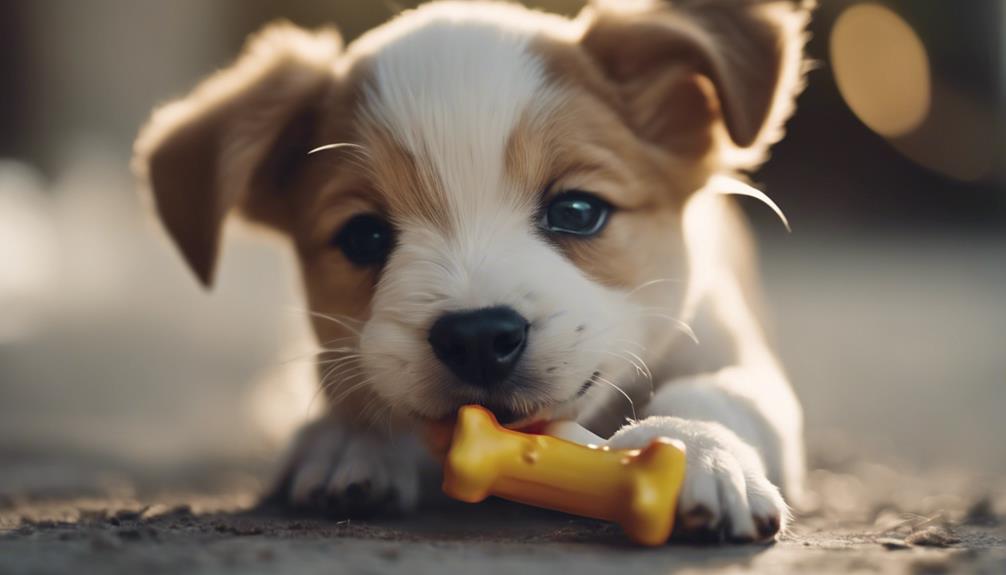
Exploring the natural progression of biting behavior in puppies provides valuable insights into their developmental phase. During their early stages, puppies use their mouths to explore the world around them, much like human babies use their hands. This biting behavior is a normal part of their teething process and social development.
As puppies interact with their littermates and humans, they learn bite inhibition, which is the ability to control the force of their bites. Most puppies naturally outgrow their biting tendencies by around four months of age as they learn appropriate social cues and boundaries through play and training.
Understanding this normal biting development in puppies can help owners navigate this phase with patience and positive reinforcement techniques.
Recognizing Aggressive Biting Signs
Aggressive biting signs in puppies may manifest through specific behavioral cues that indicate potential danger or discomfort. These signs can include intense growling, snarling, snapping, or bearing teeth in response to touch or interaction.
Aggression may also be evident if the puppy lunges towards people or other animals with the intent to harm. Additionally, a stiff body posture, raised fur along the back, and a fixed stare can signify heightened aggression levels.
It is crucial to address these behaviors promptly to prevent escalation and ensure the safety of both the puppy and those around them. Seeking professional guidance from a veterinarian or a certified dog trainer is advisable when dealing with aggressive biting tendencies in puppies.
Importance of Context in Biting Behavior
Understanding the context in which a puppy exhibits biting behavior is essential for effectively addressing and modifying this natural but potentially problematic behavior.
Context plays a crucial role in interpreting the underlying reasons for a puppy's biting tendencies. Paying attention to the circumstances surrounding the behavior, such as the puppy's body language, environment, and triggers, can provide valuable insights into whether the biting is playful, fearful, or potentially aggressive.
Veterinarian Assistance for Fearful Behavior
Seeking assistance from a qualified veterinarian is highly recommended for addressing and managing fearful behavior in puppies. Veterinarians play a crucial role in identifying the root cause of fear-based aggression and developing a tailored treatment plan to help your puppy overcome their fears. When dealing with fearful behavior in puppies, consider the following emotional aspects:
- Compassion: Veterinarians provide a compassionate approach to understanding your puppy's fears.
- Empathy: They empathize with both the puppy and the owner, offering support and guidance.
- Trust: Building trust between the veterinarian, the owner, and the puppy is essential for successful treatment.
- Hope: Through veterinary assistance, there is hope for positive behavioral changes and a happier, healthier relationship with your furry companion.
Positive Reinforcement Training Techniques
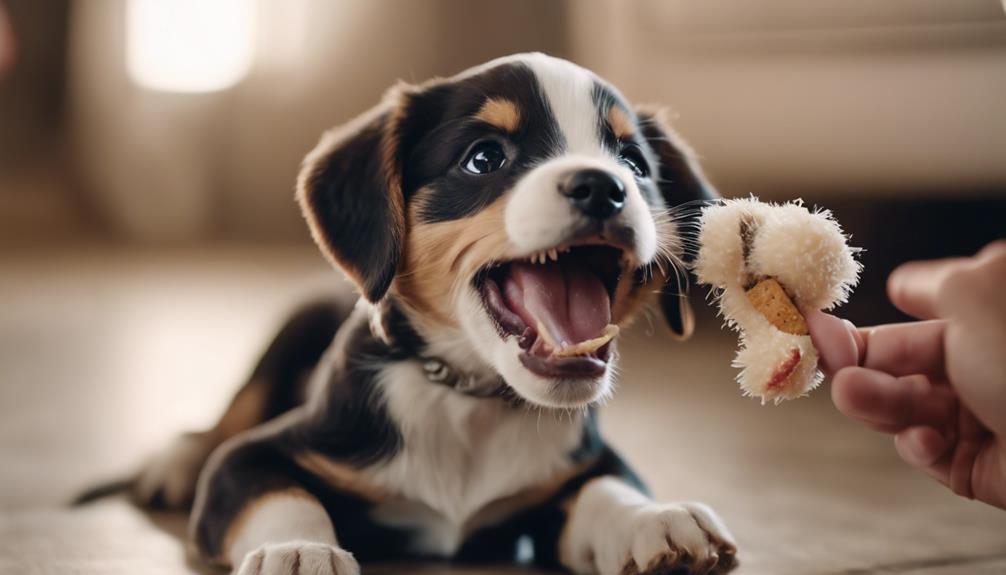
When addressing puppy biting behavior, employing positive reinforcement training techniques is key to promoting desirable behaviors and discouraging biting tendencies. Positive reinforcement involves rewarding your puppy for exhibiting good behavior, such as licking instead of biting, with treats, praise, or toys.
When your puppy engages in gentle play or refrains from biting, immediately provide positive reinforcement to reinforce this behavior. This method helps your puppy associate good behavior with positive outcomes, encouraging them to repeat these actions.
Consistency is crucial in positive reinforcement training, as it helps your puppy understand what behaviors are acceptable. By using positive reinforcement techniques consistently, you can effectively teach your puppy to replace biting with more appropriate behaviors.
Redirecting Biting With Toys
To effectively address puppy biting behavior, redirecting their focus towards appropriate chew toys is a crucial step in encouraging positive behavior. Providing puppies with engaging toys can help satisfy their natural urge to chew and bite while teaching them what items are acceptable for mouthing. This redirection technique not only protects human skin from sharp puppy teeth but also aids in promoting healthy dental habits for the growing pup.
When choosing toys for redirecting biting behavior, consider the following emotional aspects:
- Joy: Watching your puppy play happily with a toy brings a sense of delight.
- Relief: Knowing your hands are safe from sharp teeth provides peace of mind.
- Connection: Bonding over playtime with your puppy strengthens your relationship.
- Hope: Seeing your puppy learn and grow out of biting habits instills optimism for the future.
Discouraging Hand Play for Biting
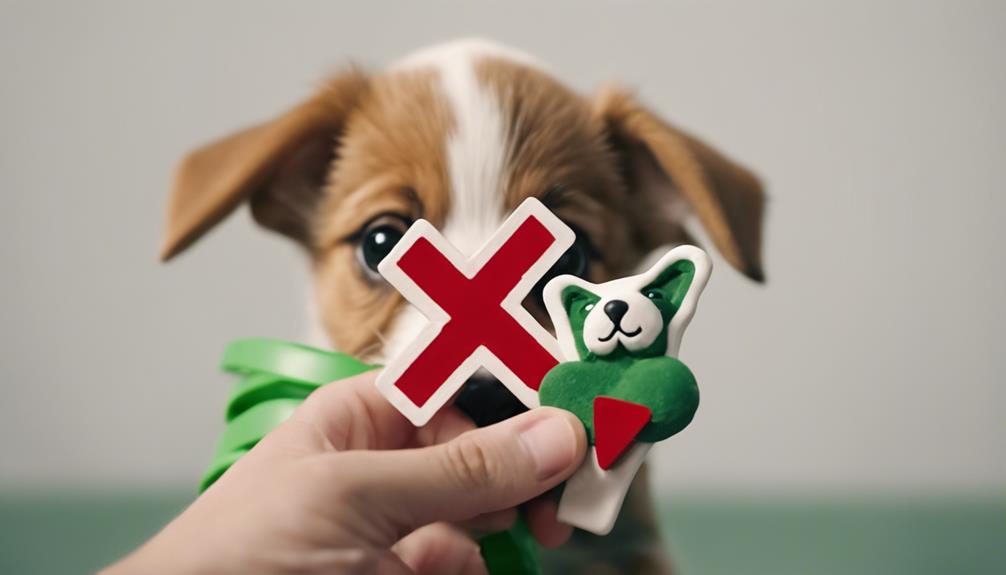
Discouraging hand play when addressing puppy biting behavior is essential to prevent reinforcement of inappropriate biting habits. Puppies may perceive hands as toys, leading to unintentional encouragement of biting behaviors.
To deter this, avoid using hands during playtime and redirect the puppy's attention to appropriate toys instead. If a puppy starts to mouth or bite your hands, calmly withdraw them and cease interaction momentarily. This pause helps the puppy understand that biting leads to the end of play.
Consistency is key in teaching puppies that hands are off-limits for biting. By establishing clear boundaries and providing suitable alternatives for play, you can effectively discourage hand play and promote positive behavior in your puppy.
Socializing Puppies for Bite Inhibition
Promoting bite inhibition in puppies through socialization is crucial for fostering appropriate interactions with other dogs and humans. Socializing your puppy effectively can help them develop self-control and understand boundaries when interacting with others.
To enhance this process and create positive experiences, consider the following emotional triggers:
- Witnessing your puppy playing joyfully with other dogs, their tails wagging in excitement.
- Seeing your puppy confidently approaching new people, eager to make friends and share affection.
- Observing your puppy engaging in gentle and controlled play, showing respect for others' space.
- Experiencing the heartwarming sight of your puppy responding calmly to different situations, demonstrating growing emotional intelligence and adaptability.
Benefits of Puppy Socialization Classes
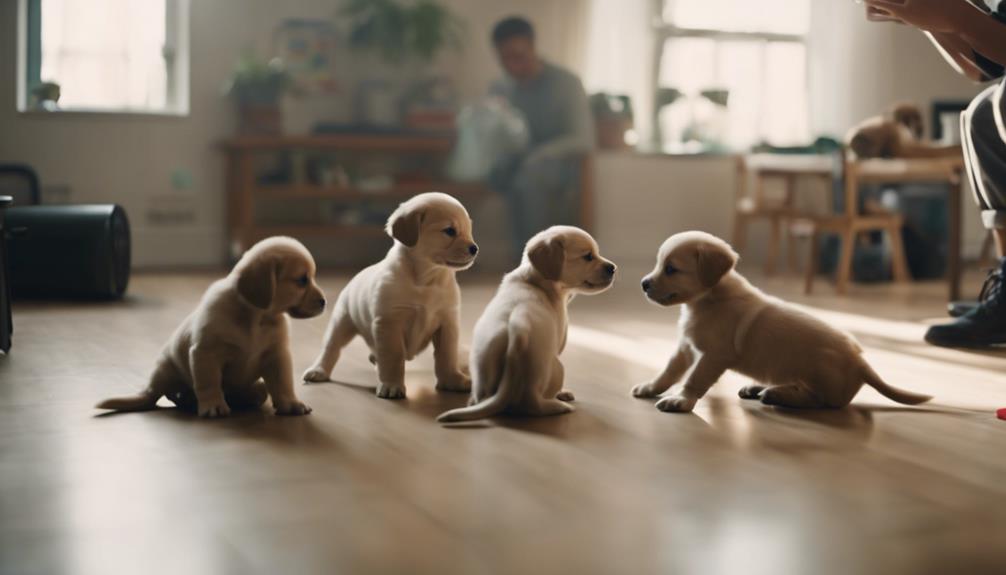
Enrolling your puppy in socialization classes can significantly enhance their behavioral development and overall well-being. These classes provide a structured environment where puppies can interact with other dogs, helping them learn vital social skills such as communication, play behavior, and proper interaction cues.
By exposing puppies to different environments, people, and animals at an early age, they become more adaptable and less likely to develop fear or aggression issues later in life. Additionally, socialization classes offer a safe space for puppies to burn off excess energy, reducing the likelihood of destructive behavior at home.
The guidance from experienced trainers in these classes can also help pet owners understand their puppy's behavior better and learn effective training techniques to address any issues that may arise.
Handling Teething Issues in Puppies
Teething in puppies is a natural developmental stage that can lead to discomfort and behavioral changes. It's essential for puppy owners to understand how to handle teething issues effectively. To help you navigate this stage with your furry friend, consider the following emotional pointers:
- Empathy: Recognize that teething can be painful for puppies.
- Patience: Understand that behavioral changes during teething are temporary.
- Compassion: Comfort your puppy during this challenging time.
- Support: Provide appropriate teething toys and objects for relief.
Quotes on the Bond With Dogs
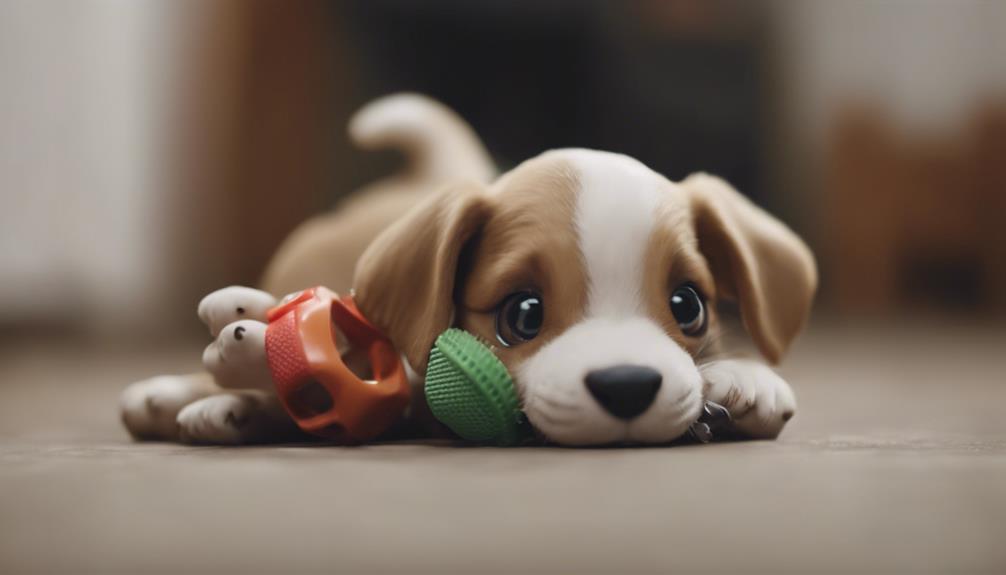
The deep connection between humans and dogs is beautifully captured in various heartfelt quotes that exemplify the bond shared between them. Renowned animal behaviorist Konrad Lorenz once said, “There is no faith which has never yet been broken, except that of a truly faithful dog.” This sentiment reflects the unwavering loyalty and love that dogs offer their human companions.
American author Dean Koontz echoed this sentiment, stating, “Once you have had a wonderful dog, a life without one is a life diminished.” Dogs have a unique ability to touch our hearts and enrich our lives with their companionship and affection. These quotes serve as a poignant reminder of the special bond that exists between humans and their canine companions.
Decoding Why Dogs Stare at Owners
Dogs often stare at their owners as a form of communication, conveying a range of emotions and intentions through this direct gaze.
- Love: The deep, unwavering gaze of a dog can signify immense love and attachment towards their owner.
- Trust: Dogs often stare to establish a sense of trust and connection with their human companion.
- Need: A prolonged stare may indicate a dog's need for attention, food, or affection.
- Understanding: Dogs can stare to seek guidance or understanding from their owners, looking for cues on how to behave or react in certain situations.
Recommended Toys for Puppies
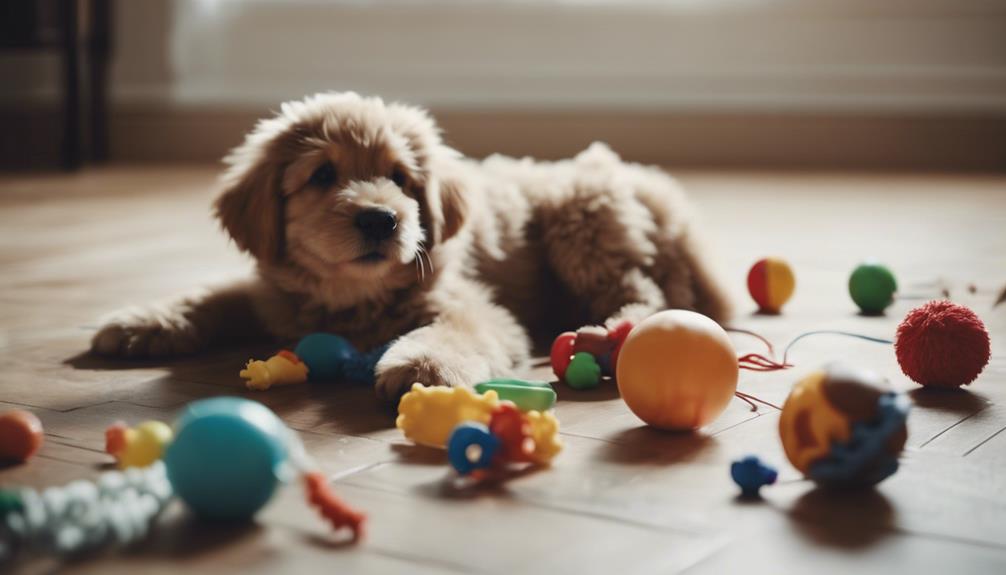
When considering the well-being and development of young canine companions, providing appropriate toys for enrichment and mental stimulation is essential. Choosing toys that cater to a puppy's natural instincts and behaviors can help redirect their biting tendencies towards acceptable items.
Look for toys that are durable, safe, and designed specifically for puppies to prevent choking hazards. Toys that can be filled with treats or have different textures to chew on are beneficial for teething puppies. Interactive toys that encourage problem-solving and physical activity can also help keep puppies engaged and mentally stimulated.
Remember to rotate toys regularly to maintain your puppy's interest and prevent boredom. By offering a variety of engaging toys, you can help satisfy your puppy's chewing needs and promote healthy play habits.
What Are Vet-Approved Tactics to Stop Puppy Biting and Nipping?
When it comes to “why dogs nibble behavior expert,” vet-approved tactics include redirecting the puppy’s attention to a chew toy, using positive reinforcement, and providing regular exercise to help release excess energy. Consistent training and supervised socialization with other dogs can also help curb biting and nipping behavior.
Conclusion
In conclusion, addressing and curbing puppy biting tendencies is a crucial aspect of responsible pet ownership.
By understanding the nuances between playful and aggressive biting behaviors, implementing positive reinforcement techniques, and seeking guidance from veterinary professionals, pet owners can effectively help their puppies develop healthy bite inhibition and social skills.
With patience, consistency, and appropriate training, pet owners can navigate and resolve puppy biting and nipping behaviors successfully.




